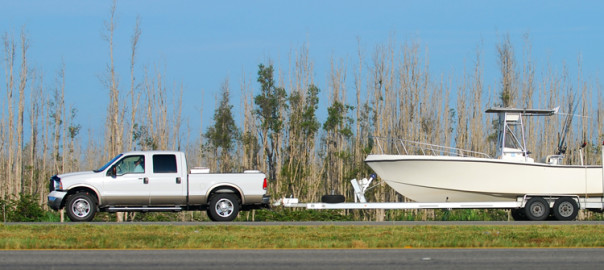Whether you’re towing a well worn dinghy or a high-end speedboat, it’s common knowledge that the kind of car you’re using to do the towing will affect the way that it handles a towed boat. Different cars yield different kinds of acceleration maneuvering, and stopping speeds. Whatever vehicle you’re using to tow your boat, here are some essential rules to follow in order to keep you (and your boat) safe and secure.
Keep Weight Balanced
While you’re loading the boat up onto whatever trailer it will be towed on, make sure that it’s weight is evenly distributed throughout – this means from both horizontal and vertical axis, from side to side, and from the entire length. You might have to shift around any other equipment inside the boat or on the trailer to find the right balance – anything can throw it off, from fuel, technical equipment, and even rations like water – make sure to stay vigilant in ensuring that the boat’s weight is evenly balanced.
Keep a flat axis
The towing vehicle and the trailer should both be exactly or just about parallel to the ground – make sure to research the trailer’s tongue weight so you can be certain that you’re not overloading the hitch with weight – the load (in this case, the boat) should weigh around 10 percent of the entire trailer’s weight.
Secure the boat tightly
Make sure the boat is securely attached to the trailer with ratchet straps, and make sure that the trailer’s winch strap is attached securely to the bow eye.
Compensate for weight when breaking
Since the trailer and towed boat adds a great deal of weight to the entire vehicle, make sure to keep this in mind while driving – your vehicle will require additional time to stop completely, so drive slow and break somewhat in advance of when you would instinctively break normally. Never make sudden starts, stops, or turns that can throw off the stability of the trailer or else the boat could fall away. When driving downhill, make sure to drive in low gear for extra traction.
Keep tools with you
You can never be too prepared. Make sure to bring a spare tire for your trailer, a lug wrench and tire gauge that fit your tires, and a grease gun for additional on the spot lubrication as needed. You don’t ever want to be caught stranded at a standstill with a boat attached to a trailer.
Be extra prudent and safe
In advance, make sure that the lights on your trailer are working properly, and just in case, make sure they are on even during the day. Before you embark, walk completely around the trailer and make sure everything looks right and that the weight seems evenly distributed. Every few miles of driving, check to make sure that no straps attaching the car has come loose – this way, even though the trip might go somewhat slower, you can be certain that you’re undertaking it with the maximum amount of safety and care.

